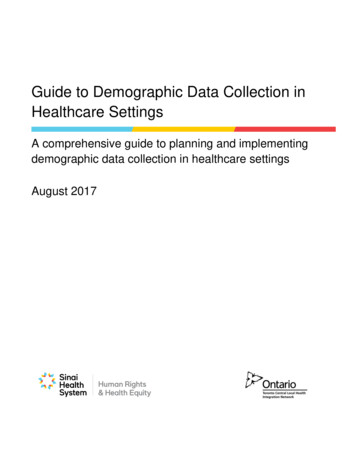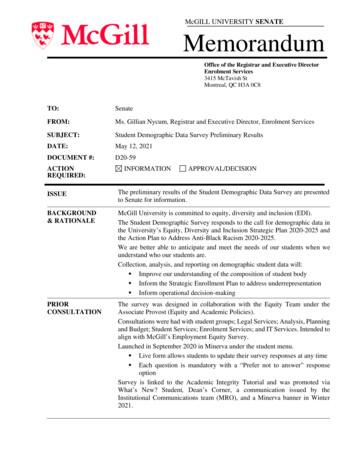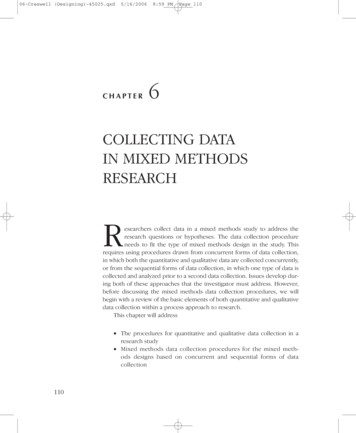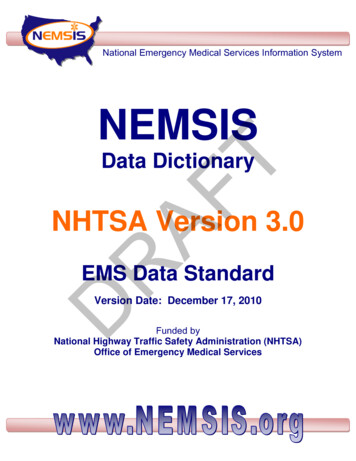
Transcription
Guide to Demographic Data Collection inHealthcare SettingsA comprehensive guide to planning and implementingdemographic data collection in healthcare settingsAugust 2017
About this guideThis document was written by the Human Rights & Health Equity Office at Sinai Health System andbased on the experience of leading the Measuring Health Equity in Toronto Central LHIN project1. Inthis role, the Office has led and coordinated demographic data collection in 16 hospitals and 17Community Health Centres (CHCs) in the Toronto Central LHIN. In addition to sharing the lessonslearned from leading the project for several years, this guide also draws from a literature review, a scanof global best practices, consultations with leading practitioners and researchers, and interviewsconducted with hospitals in Canada, the United States, and the United Kingdom.To learn more about the journey of leading demographic data collection acrossthe Toronto Central LHIN, visit torontohealthequity.ca and download“Measuring Health Equity: Demographic Data Collection and Use inToronto Central LHIN Hospitals and Community Health Centres”.AcknowledgementsSinai Health System would like to recognize the Toronto Central LHIN for their support and funding ofthe Measuring Health Equity project. Thank you for the dedicated colleagues in hospitals andCommunity Health Centres who have sought and developed solutions to collecting and embeddingdata and generously shared their thoughts and stories. And our thanks to the patients and clientsacross the Toronto Central LHIN who continue to contribute to our journey and share their information.These collective efforts contribute to the work of improving health and health equity for all.Recommended citation (APA style):Human Rights & Health Equity Office. (2017). Guide to demographic data collection in healthcaresettings. Human Rights & Health Equity Office, Sinai Health System. Retrieved from Toronto HealthEquity Website, Sinai Health System: torontohealthequity.ca1The Toronto Central LHIN is the regional health authority for the downtown/central Toronto area. To read more about theToronto Central LHIN’s mandate and work, visit: www.torontocentrallhin.on.ca
ContentsCHAPTER 1 – INTRODUCTION TO THE GUIDE1CHAPTER 2 – HEALTH EQUITY PRINCIPLES32.1. What Is Equity?32.2. Canada’s Social Determinants of Health42.3. Equity as a Component of Quality5CHAPTER 3: LAYING THE GROUNDWORK63.1. Link Demographic Data Collection to Health Equity63.2. Project Lead & Steering Committee73.3. Internal Scan9CHAPTER 4: STRATEGIES FOR SUCCESSFUL DEMOGRAPHIC DATA COLLECTION104.1. Define Goals for Data Collection104.2. Engage Senior Leadership124.3. Engage Patients/Clients and Staff124.4. Maintain Ongoing Evaluation14CHAPTER 5: DESIGN DEMOGRAPHIC DATA COLLECTION MODEL165.1. Demographic Questions165.2. Methodology and Procedures for Demographic Data Collection175.3. Patient and Data Privacy Considerations185.4. IT Solutions in Demographic Data Collection20CHAPTER 6: STAFF TRAINING226.1. Develop a Training Program226.2. Create Inclusive and Respectful Environments236.3. Highlight Challenges and Prepare Solutions24
CHAPTER 7: BEYOND DEMOGRAPHIC DATA COLLECTION257.1. Ensuring Data Quality257.2. Seeking Feedback257.3. Looking Ahead: Linking Demographic Data to Equity Planning26
Guide to Demographic Data Collection in Healthcare Settings1Chapter 1 – Introduction to the GuidePoor understanding of data collection goals, challenges with IT solutions, staff discomfort with collectingdemographic information, and patient/client reservations are all frequently cited as system-level andindividual-level barriers to sustainable demographic data collection and use2, 3.This guide wasdeveloped to help healthcare organizations overcome these challenges and embrace the opportunitiesin standardized demographic data collection. The goals of the guide are1. explain the rationale for and importance of demographic data collection2. highlight the impact of demographic data collection on improving health care quality3. provide evidence-based guidance, tools, and resources for demographic data collection.The advice in this guide is supplemented by the followingCase Studies: best practices, examplesChecklists: itemized lists to support and guide data collectionResources: reports, research articles, presentationsTools: handouts, data collection tools, communication materialsAttention: points to rememberWho is this guide for?Senior ManagementHow is patient/client demographic data collection important to your organization?CEOs and senior management are responsible for ensuring that their organization stays committed toproviding the best care possible. In the face of diverse populations and varying needs, ‘best care’requires an equity component. Equity is now a universally recognized pillar of quality care4 andgovernments are mandating demographic data collection as a precursor to equity planning5.How will you benefit from this guide?This guide reviews the challenges, opportunities and benefits of implementing a demographic datacollection plan.2Braveman P. (2014). What are health disparities and health equity? We need to be clear. Public Health Report, 2, 5-8.Human Rights & Health Equity Office. (2017). Measuring health equity: Demographic data collection and use in Toronto Central LHINhospitals and community health centres. Retrieved from Toronto Health Equity website, Sinai Health System: torontohealthequity.ca4Institute of Medicine. (2001). Crossing the quality chasm: A new health system for the 21st century. Washington, DC: The NationalAcademies Press. Retrieved from https://doi.org/10.17226/10027.5Whitehead M, Dahlgren G. (2006). Concepts and principles for tackling social inequities in health: Levelling up part 1. Geneva: WorldHealth Organization.3
Guide to Demographic Data Collection in Healthcare Settings2Quality Improvement SpecialistsHow can demographic data collection be an important part of your quality strategy?Evidence clearly points to the significant role of demographic variables, such as race and language, inshaping the quality of care experienced by patients/clients. With equity now universally recognized as apillar of quality, providing excellent care cannot be achieved without integrating an equity component.How will you benefit from this guide?This guide will introduce you to research that links demographic information to healthcare outcomes. Itwill also provide you with an understanding of data collection tools and illustrate why this data isneeded to identify gaps in quality care.Data CollectorsHow is your involvement key to successful demographic data collection?Individuals collecting the data play a significant role in determining the success of the initiative. It’simportant that you are familiar with the project’s objectives, can communicate them to patients/clientsand caregivers, and are comfortable answering questions or addressing concerns.How will you benefit from this guide?This guide will help you understand the why and the how behind the data collection process so that youfeel comfortable interacting with patients/clients and can answer any of their questions.Information Technology SpecialistsWhat is your role in supporting your organization’s demographic data collection?The IT component is key for determining what your options are for capturing, sharing, and reportingdata. Increasing your familiarity with demographic data collection goals and processes will improve yourcapacity to answer questions and develop solutions.How will you benefit from this guide?In addition to identifying the important issues that impact IT solutions (e.g., privacy, access, data entry,etc.), this guide will also review the questions that need to be addressed when building demographicfields and reports.Privacy OfficersWhat is your role in the implementation of demographic data collection?Privacy officers need to be involved to ensure that the protocols are in line with organizational andregulatory mandates. Protecting patient/client privacy will be a key element of successfulimplementation.How will you benefit from this guide?This guide includes resources and tips you can refer to as you develop data collection protocols. It alsoincludes a number of examples illustrating how other organizations have worked on data collection in amanner consistent with privacy legislation.
Guide to Demographic Data Collection in Healthcare Settings3Chapter 2 – Health Equity Principles2.1. What Is Equity?According to Health Quality Ontario, “health equity allows people to reach their full health potential andreceive high-quality care that is fair and appropriate to them and their needs, no matter where they live,what they have or who they are6” (p.7). It’s about striving for the highest possible standard of health forall, with attention to the needs of those at greatest risk of poor health based on social conditions.Research on “health inequities” reveals a number of common themes7, 8, 9: Health inequities are differences in health that are “avoidable,” “unjust,” and “unfair.”Health equity involves the fair distribution of resources needed for health, fair access to theopportunities available, and fairness in the support offered to people when ill.Equal care should not be confused with equitable care. Equitable care incorporates unique needs that people may have based on language, income,gender, etc. Equal care same care and fails to achieve equitable care.Understanding health inequities requires recognizing what the impact of the social determinants ofhealth are and how they affect patients/clients, families, and healthcare organizations. The primary factors that shape the health of Canadians are not medical treatments or lifestylechoices but rather the living conditions they experience. These conditions have come to beknown as the social determinants of health”10(p. 7).Source: Saskatoon Health Region. (2014, June). “Advancing Health Equity in Health Care”.6Health Quality Ontario. (2016). Health equity plan. Retrieved from Health Quality s/health-quality/Health Equity Plan Report En.pdf7Ibid.8Braveman P. (2014). What are health disparities and health equity? We need to be clear. Public Health Report, 2, 5-8.9Whitehead M, Dahlgren G. (2006). Concepts and principles for tackling social inequities in health: Levelling up part 1. Geneva: WorldHealth Organization.10Mikkonen, J., & Raphael, D. (2010). Social Determinants of Health: The Canadian Facts. Toronto. York University School of HealthPolicy and Management.
Guide to Demographic Data Collection in Healthcare Settings4What is the difference between ‘health inequity’ and ‘health disparity’?While sometimes used interchangeably, the terms reflect distinct interpretations for differences in healthoutcomes. The term “health disparities” refers to differences in health outcomes but does not indicatewhat the drivers of those differences may be, i.e., whether these differences are unfair or due to adisadvantage in care based on social or economic factors. On the other hand, “health inequities” implydifferences in health that are unfair, unjust, and shaped by social or economic characteristics of thepatient/client such as language, disability, gender, etc.Tool – “Towards an Understanding of Health Equity: Glossary.” A glossary of health equityterms from Alberta Health Services2.2. Canada’s Social Determinants of HealthIt has long been acknowledged that Canadians’ well-being is largely determined by “life” factors suchas race, employment, language, etc. In Canada, economic and social conditions such as income, race,and housing significantly affect Canadians’ physical and mental health beyond their lifestyle choicesand medical treatments11, 12, 13.What Makes Canadians Sick?Adapted from Canadian Medical Association’s “Health Equity and the Social Determinants of Health”11Canadian Institute of Child Health. (2000). The Health of Canada’s Children: A CICH Profile - 3rd Edition. Ottawa, Canada:Canadian Institute of Child Health.12Mikkonen, J., & Raphael, D. (2010). Social Determinants of Health: The Canadian Facts. Toronto. York University Schoolof Health Policy and Management.13Bierman, A. S. et al. (2012). Social determinants of health and populations at risk. Ontario Women’s Health Equity Report:Improving Health & Promoting Health Equity in Ontario.
Guide to Demographic Data Collection in Healthcare SettingsResource – “Social Determinants of Health: The Canadian Facts.” One of the most widelycited Canadian publications on how social and economic conditions have paved the way tosignificant health inequities across CanadaResource – “Health Equity and the Social Determinants of Health: A Role for the MedicalProfessional.” A Canadian Medical Association policy paper outlining needed action andrecommendations for addressing health inequities2.3. Equity as a Component of QualityThe U.S. Institute of Medicine [IOM] identifies six pillars of quality health care: efficient, effective, safe,timely, patient/client-centred, and equitable.Healthcare research on the link between equity and quality also shows that equity is embedded in all components of quality health care equity is a necessary condition for a “Culture of Quality” in health care unchecked inequity leads to increased pressure on healthcare services, results in unmetpatient/client needs, and reduces efficiency of healthcare provisionResource – “Crossing the Quality Chasm: A New Health System for the 21st Century”Read the IOM’s groundbreaking report that paved the way for the inclusion of equity as apillar of quality.5
Guide to Demographic Data Collection in Healthcare Settings6Chapter 3: Laying the Groundwork3.1. Link Demographic Data Collection to Health EquityMaking the case that data collection is an essential building block for ensuring equitable and qualitycare is critical. Below is a framework outlining the various components that make up an evidence-basedand data-driven approach to planning and providing equitable health care. This framework was theresult of a literature review, an environmental scan, and conversations with policy-makers,administrators, and various healthcare organisations using data to advance equity.Framework for Data-Driven Equitable Health CareCollectIdentify &ReportEvaluateImprove Collect patient/client-level demographic data: This step will give healthcare organizationsaccess to individual-level data on their patients/clients and pave the way for an evidence-basedapproach to providing equitable quality care. When done properly, demographic data serves asa fundamental building block for identifying and tracking gaps in quality of care. Identify & Report inequities in care: Once access to data is secured, organizations can developa demographic profile of the patients/clients being served and examine differences in healthoutcomes based on demographic variables such as race, language, and income. Improve care based on identified inequities and patient needs: Healthcare organizations canaddress special patient/client needs based on language, disability, religion, and so forth.Aggregating and analysing demographic data will also enable the development of programs totarget populations disproportionately affected by adverse health outcomes. Evaluate data collection practices and intervention programs: Ensuring the collection of highquality demographic data necessitates evaluating data quality and improving practices asneeded. Once an intervention is put in place to improve health equity, organizations shouldfollow up and ensure changes or new programs have met their goals.
Guide to Demographic Data Collection in Healthcare Settings7Case Study – CRC Navigator Program at Massachusetts General Hospital, an illustration ofhow demographic data was used to implement targeted programmingObjectiveIncrease colorectal cancer screening among low-income and non-English-speakingpopulationsStrategySteps 1 – 2: Collect demographic data and identify & report inequities in care:MGH stratified colon cancer screening data and found evidence of lower screening rates forlow-income and non-English-speaking populations.Step 3: Implement solutions to reduce inequities:Navigator (staff member in the program) used hospital registry to identify patients, byrace/ethnicity, who hadn’t been screened for colon cancer.Navigator worked with patient on providing targeted intervention (education, exploration ofcultural perspectives, logistical issues).Step 4: Evaluate effectiveness of solutions:CRC ScreeningCompletionProgram was associated with a significant increase in colon cancer among Hispanic 07200820092010YearJoseph Betancourt, J. R. (2012). Achieving health equity and providing quality care. Talkpresented at Measuring Health Equity in Toronto Central LHIN symposium in Toronto, ON.3.2. Project Lead & Steering CommitteeAssign Project LeadProject Lead ResponsibilitiesThe Project Lead will oversee the planning and implementation of demographic data collection acrossthe organization. This individual will lead Steering Committee meetingscoordinate and/or provide demographic data collection training
Guide to Demographic Data Collection in Healthcare Settings 8act as an internal champion for advancing equity through data collectionoversee the development and progress of a work plan, including goals, deliverables, andtimelinesProject Lead QualificationsA key quality is the ability to engage management, staff, and patients/clients. The ideal Project Lead willalso be knowledgeable on equity issues, including inequities in health care and existing access barriersfamiliar with the organization’s structure and cultureknowledgeable on health care quality principlescomfortable sharing and discussing dataForm Steering CommitteeSteering Committee Responsibilities develop a work plan that includes goals, objectives, and a timeline for the Initial Implementationof Demographic Data Collectionidentify organization stakeholders who are involved in or impacted by this projectuse feedback to improve data demographic frameworkidentify and gain consensus on equity planning goalsplan for the use of demographic data in equity planningTool – “Steering Committee Mandate.” A sample mandate that highlights the goals,operating principles, and membership requirement of the steering committeeTool – “First Meeting Agenda for Steering Committee.” A sample mandate that highlightsthe goals, operating principles, and membership requirement of the steering committeeSteering Committee ExpertiseDemographic data collection is a process that requires input from several key players. Below is a list ofimportant expertise to consider.Checklist – Steering Committee Expertise. A sample list of the expertise needed for thecommittee data administration or decision supportregistration/admission/clerical (the data collectors)privacy officer or person knowledgeable about organization’s data privacy practicesclinician – nursing, social work, physician, allied health, etc.IT person(s) who can speak to building the fields and pulling data in reportspatient relationssenior management
Guide to Demographic Data Collection in Healthcare Settings93.3. Internal ScanYour organization may already be collecting various pieces of demographic data in silos or with no planaround data monitoring and use. Examples of such cases include clinicians who may ask about religionfor chaplain or food preferences, or social workers who ask about income to assess patient/clientassistance needs.Rather than going back to the drawing board, Steering Committees can reach out to those who alreadycollect some of this data to get information on what works and what does not. What advice can datacollectors provide? What are best practices and lessons learned within your organization? Thoseconsulted can also be invited to join the Steering Committee to share their insights on successfulpractices.
Guide to Demographic Data Collection in Healthcare Settings10Chapter 4: Strategies for Successful Demographic DataCollectionOverview of Key StrategiesDefine Goals forData CollectionProvides all stakeholders with a tool for communicating the project’s visionEnsures that the short-term and long-term goals are articulatedEngage SeniorLeadershipBuilds an organization-wide dedication to demographic data collectionMaintains sustainability and accountabilityEngage Staff andPatients/ClientsEnsures that the people who connect the data, and the patients/clients who sharetheir information, stay connected to the projectStaff training on data collection is a key success factor and the most effective wayfor improving staff engagementCommit toOngoingEvaluationEnsures that the project stays committed to its purposeHelps organizations address any barriers and capitalize on opportunitiesProvides ability to continually review, improve, and monitor the project4.1. Define Goals for Data CollectionLink demographic data collection goals to visionThe majority of hospitals and CHCs include equitable and accessible care in their vision. Given thataccess to data is vital for data-driven planning and health care delivery, the organization’s vision can beused to make a strong case for embedding data collection in the organization.Identify goalsTwo of the most common questions that come up when organizations plan for data collection are“why?” and “how are you going to use the data?”. Having clear goals for data collection will providethose answers and function as a very effective engagement tool. Goals for collecting data can includetwo levels of use: Organizational-level use develop a profile of the populations being served by your organization stratify clinical indicators (e.g., cancer screening) by demographic data to identify inequities inscreening rates plan programs and services based on the communities being (or not being) served Individual-level use identifying need for accommodation or language interpretation
Guide to Demographic Data Collection in Healthcare Settings11 refer patient to services or supports interpret medical tests and treatments (e.g., for transgender individuals)America’s Health Insurance Plans association published a toolkit on using data to addresseshealth inequities. In the toolkit, they provided a number of concrete goals related todemographic data collection (see resource below):Identify key drivers ofhealth inequitiesIdentify populationdemographicsIdentify languagepreferencesDevelop organizationalcapabilities to meetpatient needs andpreferencesIdentify health inequitiesin these areas: Health status Quality of care Access to services Utilization of servicesResource – “Tools to Address Disparities in Health: Data as Building Blocks for Change.”A data collection and use toolkit for policy makers and healthcare organizationsSetting goals requires A clear vision – Identify how collecting patient/client demographic data can inform and/orimprove care.Measurable outcomes – How will an organization evaluate whether it has accomplished itsgoals? In order to evaluate goals, the Steering Committee should think of deliverables they canidentify and evaluate (e.g., participation rate targets). You can refer to the Sample Work Planbelow for examples of goals and deliverables around demographic data collection.A timeline – Setting a timeline requires prioritizing goals and objectives. For the first year ofdata collection, a realistic approach will be to profile all patients/clients you serve. As yoursample size grows and data quality improves you can start adding new milestones for data use.The Health Equity Project Coordinators will help your organization identify Goals: What is the big-picture aim of this project for us? Objectives: What should the results look like? Strategies: What are the steps for achieving those results? Deliverables: What are the quantifiable/tangible products? Timeline: How long will objectives take to accomplish?
Guide to Demographic Data Collection in Healthcare SettingsTool – “Work plan for initial implementation of demographic data collection.” A work planthat lays out the key tasks and deliverables for implementing a demographic data collectioninitiative4.2. Engage Senior LeadershipThe environmental scan of U.S., U.K., and Canadian healthcare organizations revealed severalcommon successful strategies for engaging senior leadership. Link demographic data collection to performance management by showing how it can be usedto increase service delivery, efficiency, and effectiveness. Share evidence of how demographic data has been used to improve outcomes such asresource utilization, length of stay, complications, birth weight, and managing diabetes. Highlight the capacity for demographic data to enrich understanding of quality performanceindicators. Develop a ‘concept paper’ communicating the essentials of the study and its benefits/necessityfor the organization.Resource – “Improving Health Equity through Data Collection and Use: A Guide forHospital Leaders.” A report that targets hospital leaders and outlines the rationale forcollecting demographic data; includes case studies and examples4.3. Engage Patients/Clients and StaffEngaging patients/clientsBased on input from patients, privacy officers, and organizations, healthcare organizations collectingdemographic data should share three pieces of information:WHY: Why is our organization collecting demographic data?The consensus is that when patients/clients understand the importance of sharing their demographicdata they are significantly more likely to share that information14. Share your goals for demographicdata collection, such as outlining how the data can be used to plan services and provide actionablerecommendations for staff (e.g., identify need for interpreter).WHO: Who has access to your demographic data?A significant piece of consent and comfort with sharing the data is knowing who will have access to itboth internally (e.g., ‘your healthcare team’) and externally (e.g., ‘research’) and how you’re protectingit.OPTIONAL: Do you have to respond to all questions?We highly recommend that patients/clients have the option of ‘prefer not to answer’ to any or all of thequestions. This respects their right to not participate and makes staff more comfortable about asking.14New Hampshire Health & Equity Partnership, (nd). Data: Key points, recommendations, current initiatives, and resources.Retrieved from http://www.healthynh.com/nhhep-data.html12
Guide to Demographic Data Collection in Healthcare SettingsCase study – Introduction to the ‘Toronto Central LHIN Demographic Questions.’ Below isthe introduction that Toronto Central LHIN hospitals include in their demographic forms. Itserves as one example of how the three message above can be worded.We are collecting social information from patients to find out who we serve and whatunique needs our patients have. We will also use this information to understand patientexperiences and outcomes.Do I have to answer all the questions?No. The questions are voluntary and you can choose ‘prefer not to answer’ to any or allquestions. This will not affect your care.Who will see this information?This information will be visible only to your healthcare team and protected like all yourother health information. If used in research, this information will be combined with datafrom all other patients and no one will be able to identify any of the patients.For more examples on how to communicate with patients/clients about data collection, please refer toChapter 6: Staff Training.You can additionally engage patients/clients through communication tools such as posters placed neardata collection locations and brochures that address frequently asked questions.Tool – ‘We Ask Because We Care’ patient/client poster. A poster that can be placed inarea of data collection; available in French on torontohealthequity.ca/tools/Tool – ‘We Ask Because We Care’ patient/client brochure. A brochure that is written inplain English and reviews the most common questions on demographic data collection;available in 11 languages on toronthealthequity.ca/tools/Engaging staffWhile early resistance to data collection tends to focus on patient/client reactions, organizations thathave been collecting data for a long time indicate that staff resistance persists even afterpatients/clients are shown to be open to data collection. In fact, staff resistance is the most commonlycited barrier to demographic data collection15, and is often driven by 15poor and inconsistent training on asking demographic questionsunfamiliarity with project goalsfailure to clearly communicate why we need the data and the workflow for collecting itdiscomfort with demographic data collection elements (e.g., gender, sexual orientation)Interviews during the period of August–October 2012 with Guwan Jones (Director of Health Equity at Texas Baylor HealthCare System), Nancy Connery (Director of Admitting and Registration Services at Massachusetts General Hospital), NatalieSabino (Lehigh Valley Health Network Diversity/Cultural Liaison), Romana Hasnain-Wynia (Director and Scientific ProgramLeader at Patient Centered Outcomes Research Institute), and Sarah Bowen (Professor in the School of Public Health at theUniversity of Alberta)13
Guide to Demographic Data Collection in Healthcare Settings14PresentationsPresentations tailored to the audience and the venue may be given at staff meetings and workshops.While the key messages will be the same, the focus may shift slightly depending on the group. Managers and supervisors may be most interested in learning about how access todemographic data can transform health care planning and delivery.Staff directly working with patients/clients will be looking for information on how data collectionfits with thei
Social Determinants of Health: The Canadian Facts. Toronto. York University School of Health Policy and Management. 13 Bierman, A. S. et al. (2012). Social determinants of health and populations at risk. Ontario Women's Health Equity Report: Improving Health & Promoting Health Equity in Ontario.











